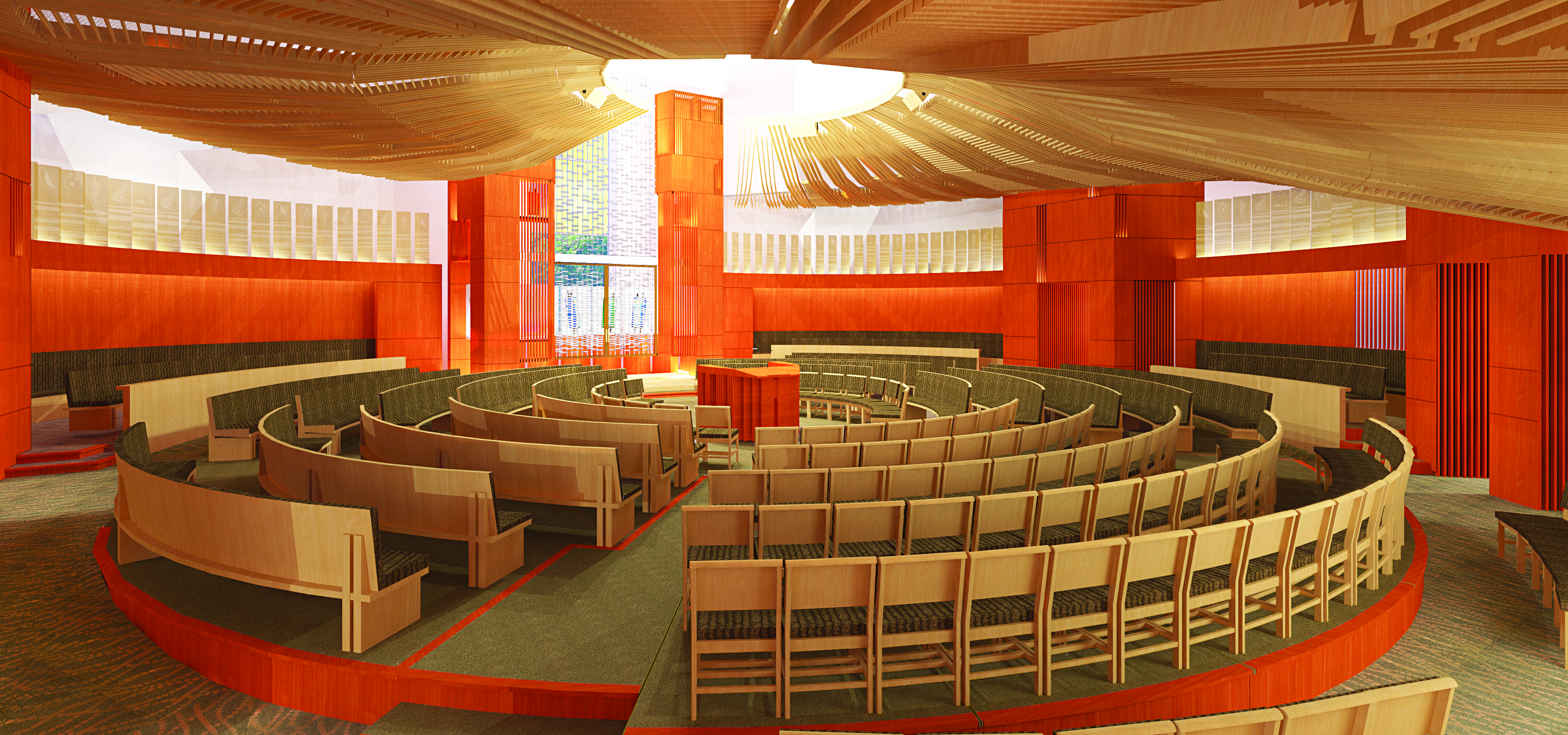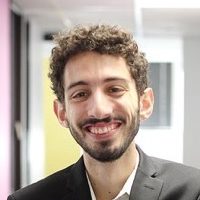 Image courtesy of Temple Beth Am
Image courtesy of Temple Beth Am If you have read about recent demographic studies claiming fewer young American Jews are marrying inside the faith and affiliating with Jewish organizations, you might think organized Jewish life in the United States is on its way out.
But Los Angeles donors have a response to those studies: Want to bet on it?
In the last two years, more than $100 million has been dedicated to renovation and construction projects at schools and synagogues across L.A., and much more is expected to be raised through ongoing capital campaigns that aim to build facilities for the next generations of Jews.
Together, these projects represent the collective optimism of a Jewish community unfazed by seemingly gloomy population studies, according to clergy, donors and lay leaders.
The projects currently underway are spread across the San Fernando Valley and the Los Angeles Basin. They consist of new schools and school expansions, custom-built synagogues and old sanctuaries in need of facelifts. And they are being carried out within the three major spiritual movements: Temple of the Arts in Beverly Hills, a Reform congregation, has plans to build a new preschool; Conservative synagogues Valley Beth Shalom (VBS) and Temple Beth Am are constructing new school buildings; and among Orthodox communities, Harkham Hillel Hebrew Academy is engaged in a $20 million renovation, while Chabad of South La Cienega (SOLA) is building a new, multi-use religious facility.
At Temple Beth Am, synagogue leadership has raised $25 million to renovate its main sancutary and construct a middle school building for its Pressman Academy day school.
“What could reflect more optimism in the school and the synagogue than that kind of effort?” said Temple Beth Am building committee co-chair Avi Peretz, who said he has donated a significant sum.
To Peretz, donations reflect a sense of obligation and a feeling of responsibility to proverbially set the table for the next generation of Jews.
Peretz recalled walking into Pressman Academy on the first day of school for his daughter, who is now 21, and saying to himself, “ ‘Wow, look what somebody built. Somebody built this school that my daughter gets to go to classes in. Somebody built it knowing full well that probably their own kids wouldn’t be the ones that got to benefit from it.’ But the sense of obligation you feel is that other people came before you and did the work that you’re benefiting from. It’s now your turn to do the work.”
The groundwork of breaking ground
Even before construction begins, planning and permitting can be complicated, time-consuming and costly.
Adas Torah, an Orthodox congregation that razed a Pico Boulevard furniture store to open a new synagogue building in September 2016, spent more than $20,000 in permitting fees alone, Los Angeles Department of Building and Safety records show.
“It’s a long process,” said Trevor Abramson, whose firm, Abramson Teiger Architects, has designed a half-dozen synagogue buildings in the past 15 years, including the project currently underway at VBS. “It takes time to draw up plans, to build consensus with the community, to get the plans approved by the community, and then also get approved by the city — and then to raise the money.
“There are some synagogues being built right now in L.A. where the wheels have been in the motions for the last three years or more,” Abramson said.
Pressman Academy’s expansion plans have been in the works for about a decade. Over that period, Temple Beth Am, directly or through its members, quietly bought eight contiguous apartment buildings on Corning Street, directly behind the temple’s La Cienega Boulevard compound. Nine years ago, it converted one building into an early childhood center, and two years ago, it razed two more to create an outdoor play space.
When Erica Rothblum joined Pressman Academy as head of school in July 2014, synagogue leadership had already judged that “the school building was bursting at the seams,” she said.
Rothblum had the idea to build a new middle school that would not just increase retention — class sizes tend to shrink as grade levels increase — but serve as the Jewish day school of the future.
“We’re not building just a prettier version of a traditional school building,” she said. “We’re actually changing how the school looks and functions. In some ways, it’s going to look more like a Google office than the school buildings we’re all used to.”
Buying in and building up
Often, the first step in a construction project is winning the buy-in of parents and congregants. “A house is really just an endeavor for an owner, but when you’re designing a synagogue or a religious building, that’s really for the whole community,” Abramson said.
Abramson’s firm designed a community center now under construction at VBS for dual use by the synagogue and its day school. Plans for that project date back 15 years, according to VBS Executive Director Bart Pachino.
Timing can depend on permitting, donor interest or even the national economy. Construction at VBS was delayed at least five years after the Great Recession as donor funds dried up, Pachino said.
Before Abramson and his employees start drawing on a synagogue project, they gather congregants for a town hall meeting about the needs for a new building.
“We like to listen to what everybody thinks the needs are,” he said. “And it’s super interesting, because some people are worried about where they can park, and some people are worried about the spiritual aspect of the synagogue, and some people are worried about saving the plaque on the wall that’s been there since 1852.”
By the time VBS broke ground in September, it had raised $26 million for the new center and for renovations to its existing buildings.
“That’s the greatest compliment a rabbi can get when somebody says, ‘I’m willing to work with you, and I’m willing to share my resources and time, and I want this to continue past me,’ ” said Rabbi Ed Feinstein, the Encino synagogue’s senior rabbi. “It’s a great statement.”
Bursting at the seams
The Montessori preschool run by Chabad of SOLA began seven years ago as a mommy-and-me group with eight children. Today, it has more than 80.
Until recently, the children gathered in the same space that served as home to four minyans — Chabad, Sephardic, teens and young couples. That arrangement presented challenges, such as having to take down folding chairs and movable walls each weekend, said Stery Zajac, the preschool’s director.
In December 2014, The Eiden Project — a nonprofit organization set up to build a new community center, mikveh and preschool for Chabad of SOLA — bought a 21,000-square-foot property at Airdrome Street and La Cienega Boulevard for $4.5 million, according to Josh Moorvitch, who runs a mortgage company and sits on The Eiden Project board.
The property was home to two car dealerships in separate buildings, one of which now temporarily houses the preschool. Recently, Chabad of SOLA began renovations to transform the empty dealership into a preschool building, Moorvitch said. After that project is completed, the congregation intends to raze the other building to create a new mikveh for men and women and a synagogue building. Moorvitch said there was a “tremendous demand” for the mikveh, as the closest one is Mikvah Esther, about 1 1/2 miles away.
Another Orthodox Jewish school, Harkham Hillel Hebrew Academy, also is planning an expansion. Its head of school, Rabbi Boruch Sufrin, recently announced that the Orthodox kindergarten-through-eighth-grade day school would undertake a $20 million renovation.
In recent years, Hillel’s enrollment has increased some 20 percent to 650 students. After a two- to three-year renovation process, including planning and obtaining city approvals, it hopes to have a campus for 700, Sufrin said.
Before its capital campaign went public this fall, the school had quietly raised about $10 million, half of its total goal, he said.
“The project itself brings a certain amount of optimism and hope and joy about the community,” Sufrin said. “People are looking and saying, ‘Wow, I’m going to be a part of sustaining the next 20 or 30 years of the community.’ And that means a lot to these people.”
Money management
Chabad of SOLA and Pressman Academy have taken different approaches to funding their building projects.
“There are schools in this community where they’ve raised 10 percent before they begin construction, and I know heads of schools that want 100 percent,” Rothblum said.
Pressman is somewhere in the middle, having raised $25 million of the $30 million it estimates it will need — enough that it feels confident breaking ground as soon as January, she said.
Sometimes, breaking ground can accelerate the fundraising process.
“We’ve definitely had people say to us, ‘Once I see construction, you can come talk to me,’ ” Rothblum said. “I’ve had other people say, ‘Right here, right now, I’m willing to invest in this and be a leader.’ ”
While Pressman Academy waited to raise more than 80 percent of its needed funds, Chabad of SOLA broke ground on its $1.4 million preschool project after collecting about $600,000. Moorvitch said that decision was based on confidence in the generosity of community members once they see construction underway.
“In breaking ground, our goal was to have the school open as quickly as possible for our families,” he said. “It wasn’t a choice to wait around. We had to break ground, and we have to move this project along. And we’re going to do it.”
Demographics be damned
Schools and synagogues that are literally mortgaging their futures for expansions and renovations face some troubling national trends. A 2013 Pew Research Study of American Jews painted a dismal picture that some analysts have interpreted as a death knell for synagogue life in the United States. In particular, the study focused on the increasing number of “Jews of no religion,” or cultural Jews — those who check “None” when asked about their religious practice. These Jews, in turn, are less likely to affiliate with religious institutions and attend synagogue. Whereas 39 percent of Jews by religion report belonging to a congregation, only 4 percent of those in the secular demographic do, the study found.
But the synagogues and schools working their way through their respective building projects say that overall trend doesn’t apply to them.
“The Pew study is not everybody’s written destiny,” said Temple Beth Am President Susan Hetrsoni. “It’s time to take it on.”
Hetrsoni said that membership at Temple Beth Am has held steady in recent years. Valley Beth Shalom’s membership has increased over the past five years to more than 1,500 families, a fact Feinstein attributes at least in part to a growing need for spiritual connection.
“L.A.’s a funny city,” Feinstein said. “We have these giant block walls that separate our homes from each other. People don’t know their neighbors, so you want to belong to something. You want people to know who you are. People are craving that in this moment of history.”
But L.A. is not the only metropolitan area defying national statistics, he said. His clergy friends in places such as Boston, Chicago, New York and Atlanta report similarly encouraging trends.
“In lots of pockets all over the country this is happening,” Feinstein said. “I wish I could take full credit for it and say it’s the genius of my rabbinate — but it’s certainly not.”























 More news and opinions than at a Shabbat dinner, right in your inbox.
More news and opinions than at a Shabbat dinner, right in your inbox.